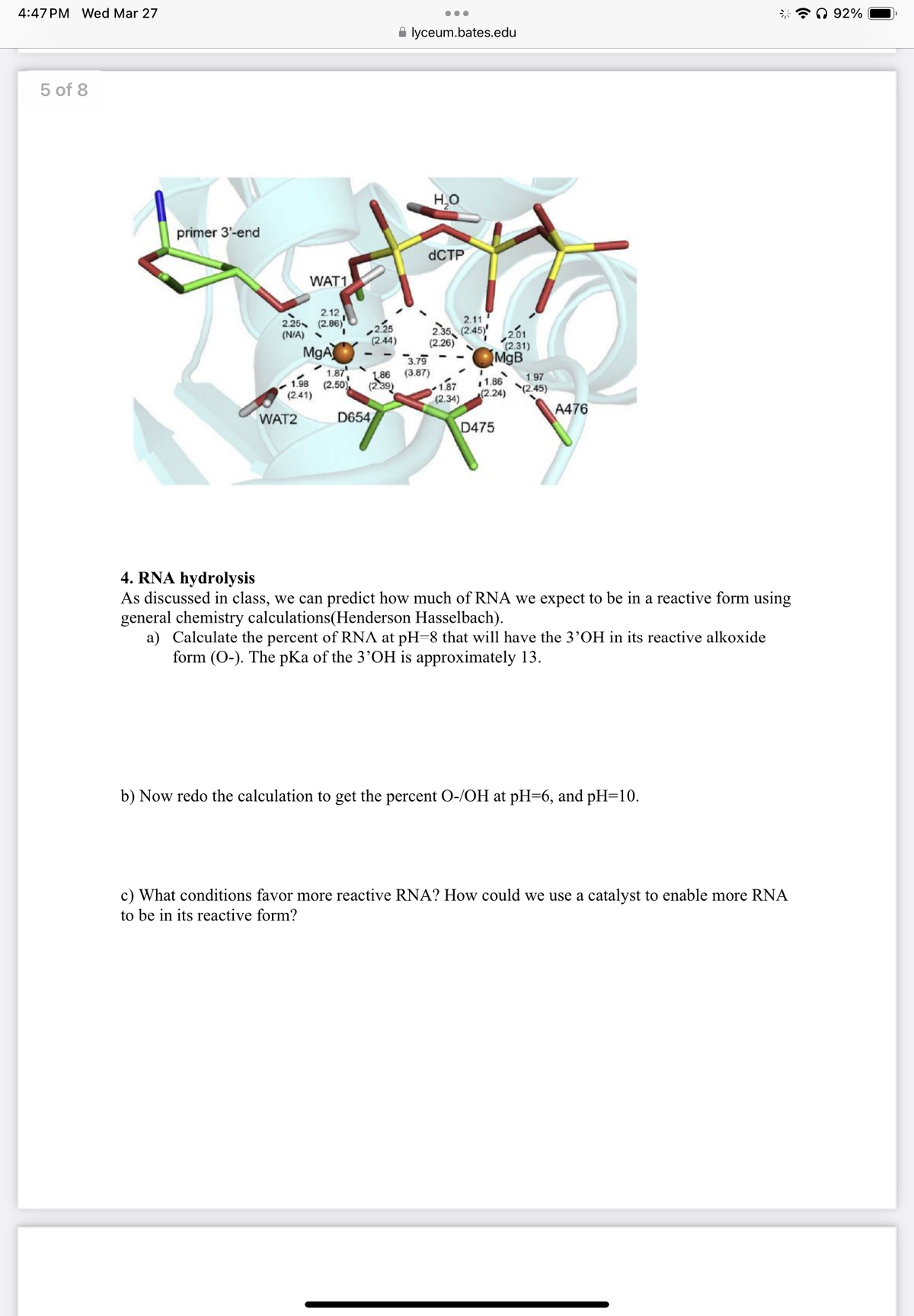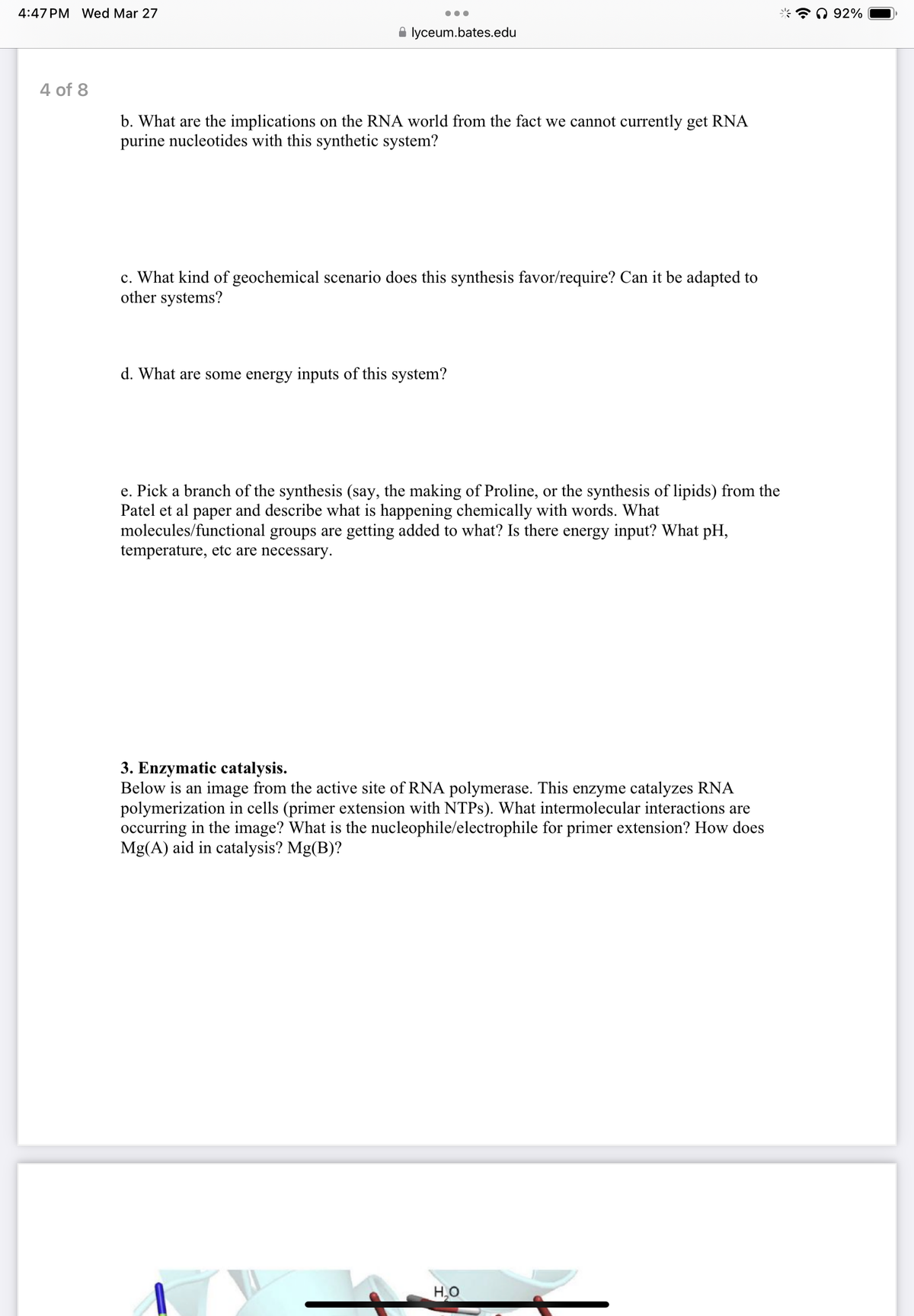4:47 PM Wed Mar 27 ... lyceum.bates.edu 5 of 8 primer 3'-end WAT1 2.12 H₂O dCTP 2.25 (2.86) 2.11 (N/A) - 2.25 (2.44) MgA 2.35 (2.45) (2.26) 2.01 (2.31) 3.79 MgB 1.87' 1.86 (3.87) 1.98 (2.50) (2.41) (2.39) 1.86 1.97 1.87 (2.24) (2.45) (2.34) WAT2 D654 A476 D475 4. RNA hydrolysis As discussed in class, we can predict how much of RNA we expect to be in a reactive form using general chemistry calculations(Henderson Hasselbach). a) Calculate the percent of RNA at pH=8 that will have the 3'OH in its reactive alkoxide form (O-). The pKa of the 3'OH is approximately 13. b) Now redo the calculation to get the percent O-/OH at pH=6, and pH=10. c) What conditions favor more reactive RNA? How could we use a catalyst to enable more RNA to be in its reactive form? ດ 92% 4:47 PM Wed Mar 27 4 of 8 lyceum.bates.edu b. What are the implications on the RNA world from the fact we cannot currently get RNA purine nucleotides with this synthetic system? c. What kind of geochemical scenario does this synthesis favor/require? Can it be adapted to other systems? d. What are some energy inputs of this system? e. Pick a branch of the synthesis (say, the making of Proline, or the synthesis of lipids) from the Patel et al paper and describe what is happening chemically with words. What molecules/functional groups are getting added to what? Is there energy input? What pH, temperature, etc are necessary. 3. Enzymatic catalysis. Below is an image from the active site of RNA polymerase. This enzyme catalyzes RNA polymerization in cells (primer extension with NTPs). What intermolecular interactions are occurring in the image? What is the nucleophile/electrophile for primer extension? How does Mg(A) aid in catalysis? Mg(B)? H₂O 92%
4:47 PM Wed Mar 27 ... lyceum.bates.edu 5 of 8 primer 3'-end WAT1 2.12 H₂O dCTP 2.25 (2.86) 2.11 (N/A) - 2.25 (2.44) MgA 2.35 (2.45) (2.26) 2.01 (2.31) 3.79 MgB 1.87' 1.86 (3.87) 1.98 (2.50) (2.41) (2.39) 1.86 1.97 1.87 (2.24) (2.45) (2.34) WAT2 D654 A476 D475 4. RNA hydrolysis As discussed in class, we can predict how much of RNA we expect to be in a reactive form using general chemistry calculations(Henderson Hasselbach). a) Calculate the percent of RNA at pH=8 that will have the 3'OH in its reactive alkoxide form (O-). The pKa of the 3'OH is approximately 13. b) Now redo the calculation to get the percent O-/OH at pH=6, and pH=10. c) What conditions favor more reactive RNA? How could we use a catalyst to enable more RNA to be in its reactive form? ດ 92% 4:47 PM Wed Mar 27 4 of 8 lyceum.bates.edu b. What are the implications on the RNA world from the fact we cannot currently get RNA purine nucleotides with this synthetic system? c. What kind of geochemical scenario does this synthesis favor/require? Can it be adapted to other systems? d. What are some energy inputs of this system? e. Pick a branch of the synthesis (say, the making of Proline, or the synthesis of lipids) from the Patel et al paper and describe what is happening chemically with words. What molecules/functional groups are getting added to what? Is there energy input? What pH, temperature, etc are necessary. 3. Enzymatic catalysis. Below is an image from the active site of RNA polymerase. This enzyme catalyzes RNA polymerization in cells (primer extension with NTPs). What intermolecular interactions are occurring in the image? What is the nucleophile/electrophile for primer extension? How does Mg(A) aid in catalysis? Mg(B)? H₂O 92%
Biochemistry
6th Edition
ISBN:9781305577206
Author:Reginald H. Garrett, Charles M. Grisham
Publisher:Reginald H. Garrett, Charles M. Grisham
Chapter30: Protein Synthesis
Section: Chapter Questions
Problem 21P
Related questions
Question
Can you help with q3 please, thank you.

Transcribed Image Text:4:47 PM Wed Mar 27
...
lyceum.bates.edu
5 of 8
primer 3'-end
WAT1
2.12
H₂O
dCTP
2.25 (2.86)
2.11
(N/A) -
2.25
(2.44)
MgA
2.35 (2.45)
(2.26)
2.01
(2.31)
3.79
MgB
1.87'
1.86 (3.87)
1.98 (2.50)
(2.41)
(2.39)
1.86
1.97
1.87
(2.24)
(2.45)
(2.34)
WAT2
D654
A476
D475
4. RNA hydrolysis
As discussed in class, we can predict how much of RNA we expect to be in a reactive form using
general chemistry calculations(Henderson Hasselbach).
a) Calculate the percent of RNA at pH=8 that will have the 3'OH in its reactive alkoxide
form (O-). The pKa of the 3'OH is approximately 13.
b) Now redo the calculation to get the percent O-/OH at pH=6, and pH=10.
c) What conditions favor more reactive RNA? How could we use a catalyst to enable more RNA
to be in its reactive form?
ດ 92%

Transcribed Image Text:4:47 PM Wed Mar 27
4 of 8
lyceum.bates.edu
b. What are the implications on the RNA world from the fact we cannot currently get RNA
purine nucleotides with this synthetic system?
c. What kind of geochemical scenario does this synthesis favor/require? Can it be adapted to
other systems?
d. What are some energy inputs of this system?
e. Pick a branch of the synthesis (say, the making of Proline, or the synthesis of lipids) from the
Patel et al paper and describe what is happening chemically with words. What
molecules/functional groups are getting added to what? Is there energy input? What pH,
temperature, etc are necessary.
3. Enzymatic catalysis.
Below is an image from the active site of RNA polymerase. This enzyme catalyzes RNA
polymerization in cells (primer extension with NTPs). What intermolecular interactions are
occurring in the image? What is the nucleophile/electrophile for primer extension? How does
Mg(A) aid in catalysis? Mg(B)?
H₂O
92%
Expert Solution
This question has been solved!
Explore an expertly crafted, step-by-step solution for a thorough understanding of key concepts.
This is a popular solution!
Trending now
This is a popular solution!
Step by step
Solved in 1 steps

Recommended textbooks for you

Biochemistry
Biochemistry
ISBN:
9781305577206
Author:
Reginald H. Garrett, Charles M. Grisham
Publisher:
Cengage Learning

Biochemistry
Biochemistry
ISBN:
9781305577206
Author:
Reginald H. Garrett, Charles M. Grisham
Publisher:
Cengage Learning